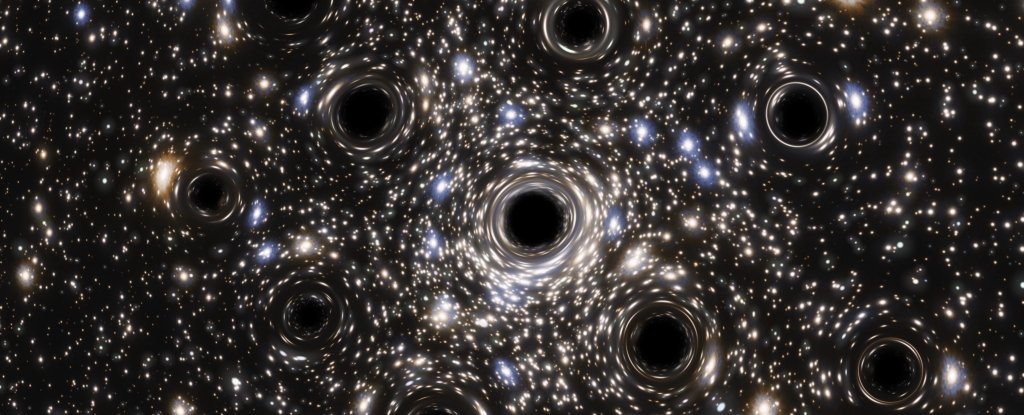An Entire Swarm of Black Holes Has Been Caught Moving Through The Milky Way
- Get link
- X
- Other Apps

An Entire Swarm of Black Holes Has Been Caught Moving Through The Milky Way
MICHELLE STARR
7 JULY 2021
A fluffy cluster of stars spilling across the sky may have a secret hidden in its heart: a swarm of over 100 stellar-mass black holes.
If this finding can be validated, it will explain how the cluster came to be the way it is - with its stars spaced light-years apart, smearing out into a stellar stream stretching across 30,000 light-years.
The star cluster in question is called Palomar 5, located around 80,000 light-years away. Such globular clusters are often considered 'fossils' of the early Universe. They're very dense and spherical, typically containing roughly 100,000 to 1 million very old stars; some, like NGC 6397, are nearly as old as the Universe itself.
In any globular cluster, all its stars formed at the same time, from the same cloud of gas. The Milky Way has around 150 known globular clusters; these objects are excellent tools for studying, for example, the history of the Universe, or the dark matter content of the galaxies they orbit.
But there's another type of star group that is gaining more attention - tidal streams, long rivers of stars that stretch across the sky. Previously, these had been difficult to identify, but with the Gaia space observatory working to map the Milky Way with high precision in three dimensions, more of these streams have been brought to light.
"We do not know how these streams form, but one idea is that they are disrupted star clusters," explained astrophysicist Mark Gieles of the University of Barcelona in Spain.
"However, none of the recently discovered streams have a star cluster associated with them, hence we can not be sure. So, to understand how these streams formed, we need to study one with a stellar system associated with it. Palomar 5 is the only case, making it a Rosetta Stone for understanding stream formation and that is why we studied it in detail."
Palomar 5 appears unique in that it has both a very wide, loose distribution of stars and a long tidal stream, spanning more than 20 degrees of the sky, so Gieles and his team homed in on it.
The team used detailed N-body simulations to recreate the orbits and evolutions of each star in the cluster, to see how they could have ended up where they are today.
Since recent evidence suggests that populations of black holes could exist in the central regions of globular clusters, and since gravitational interactions with black holes are known to send stars careening away, the scientists included black holes in some of their simulations.
Their results showed that a population of stellar-mass black holes within Palomar 5 could have resulted in the configuration we see today. Orbital interactions would have slingshot the stars out of the cluster and into the tidal stream, but only with a significantly higher number of black holes than predicted.
The stars escaping the cluster more efficiently and readily than black holes would have altered the proportion of black holes, bumping it up quite a bit.
"The number of black holes is roughly three times larger than expected from the number of stars in the cluster, and it means that more than 20 percent of the total cluster mass is made up of black holes," Gieles said.
"They each have a mass of about 20 times the mass of the Sun, and they formed in supernova explosions at the end of the lives of massive stars, when the cluster was still very young."
In around a billion years, the team's simulations showed, the cluster will dissolve completely. Just before this happens, what remains of the cluster will consist entirely of black holes, orbiting the galactic center. This suggests that Palomar 5 is not unique, after all - it will dissolve completely into a stellar stream, just like others that we have discovered.
It also suggests that other globular clusters will likely share the same fate, eventually. And it offers confirmation that globular clusters may be excellent places to look for black holes that will eventually collide, as well as the elusive class of middleweight black holes, between stellar mass lightweights and supermassive heavyweights.
"It is believed that a large fraction of binary black hole mergers form in star clusters," said astrophysicist Fabio Antonini of Cardiff University in the UK.
"A big unknown in this scenario is how many black holes there are in clusters, which is hard to constrain observationally because we can not see black holes. Our method gives us a way to learn how many black holes there are in a star cluster by looking at the stars they eject."
The research has been published in Nature Astronomy.

Comments
Post a Comment